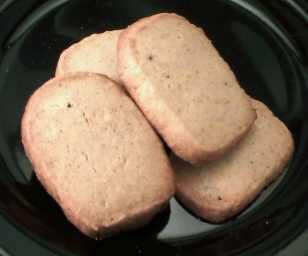“Sable” is French for sand which describes the texture of this classic cookie. Here is my take on the sable, with the flavor of beurre noisette and orange. I call them “Sables++” because of my computer programming background. The programming language C++ is an augmentation of the C language; my Sables++ recipe is an augmentation of the classic sable recipe.

- 1 lb (4 sticks) of butter at room temperature, divided
- 1/2 cup powdered sugar
- 1 cup white sugar
- 3 large eggs at room temperature
- 1 teaspoon vanilla extract
- 1 orange for zesting
- 3 cups bleached all-purpose flour, sifted
- 1 teaspoon baking powder
- 1 teaspoon table salt
- 2 teaspoons water
Put a coffee filter into a metal hand-held strainer and place it over a heat-proof bowl. Set this aside, but within reach. Place 1/2 pound (2 sticks) of the butter in a sturdy saucepan and cook it to the beurre noisette stage. When finished, immediately pull the saucepan from the heat and carefully strain the beurre noisette through the coffee filter and into the bowl, scraping the bottom of the pan to make sure all of the caramelized butter solids are in the coffee filter. You will have trouble getting all of the melted butter through the coffee filter, so coax it with the back of a metal spoon to filter as much butter as possible into the collection bowl. A small amount of residual melted butter is fine, but you must try to minimize it as much as possible. (You won’t be using the liquid butter in this recipe, but you don’t have to throw it away; you could use it to make Ghee and Orange Juice Cake.)
Fit your stand mixer with the paddle attachment. Put the remaining butter into the mixer’s bowl and cream it on medium speed for two minutes. Add the powdered sugar and cream on medium speed for another two minutes. Add the white sugar and cream on medium speed for another two minutes.
Remove the bowl from the mixer. Place a microplane over the bowl and remove the zest of the orange into the bowl. Add two of the eggs and the vanilla extract. Carefully scrape all of the caramelized butter solids from the coffee filter and add them to the bowl. Return the bowl to the mixer and combine well, until creamy, on medium-high speed. Scrape the bottom of the bowl as necessary.
In another bowl, combine the sifted flour, baking powder and salt. Stir until thoroughly combined, about two minutes. Add all at once to the stand mixer and mix on low speed just until thoroughly combined.
Divide the dough in two and place on a lightly-floured surface. Roll into logs of about 1.25 inch diameter, cover in plastic wrap and refrigerate for at least 2 hours.
When the dough is well-chilled, heat your oven to 350 degrees Fahrenheit. Prepare an egg wash by beating together the remaining egg and the 2 teaspoons of water. Set it aside. Remove the dough from the refrigerator and cut into wafers 1/4 inch thick. Get each slice as accurate as possible because the thickness of the dough must be exact for the cookies to bake properly. Place the slices on ungreased cookie sheets. If you want, you can use a fork to score the tops of the cookies creating a cross-hatch pattern. Using a pastry brush, dab the tops of the cookies with the egg wash.
Bake for 12 to 16 minutes, until the edges are brown. Remove from the oven and allow the cookies to cool for a minute or two on the tray. Transfer to a wire rack and cool the cookies to room temperature. Store in an airtight container.